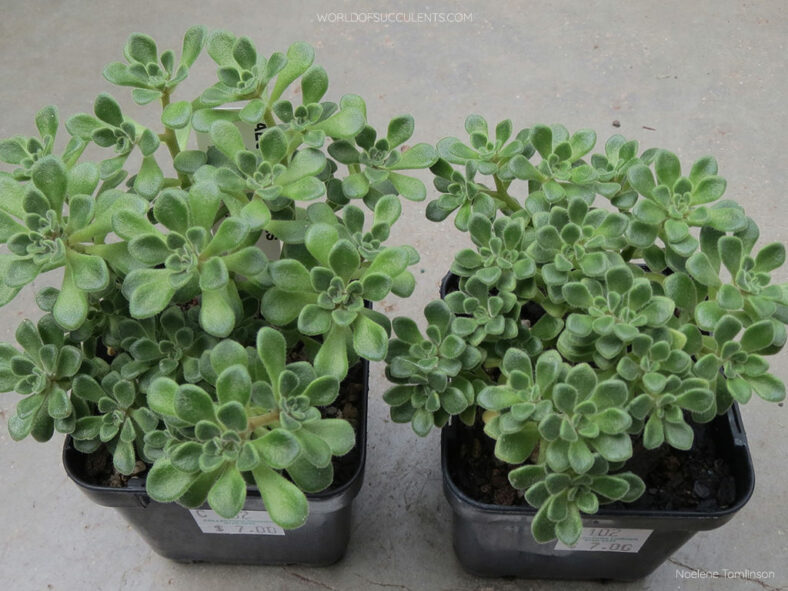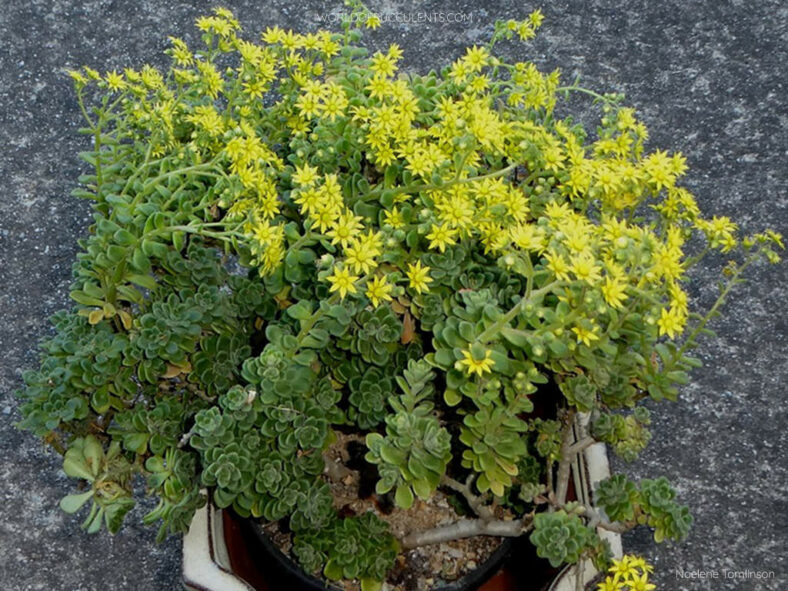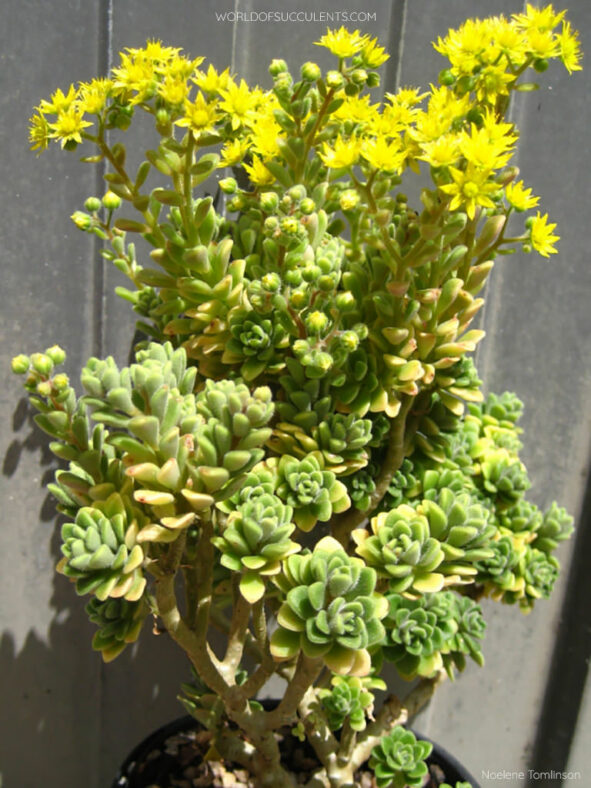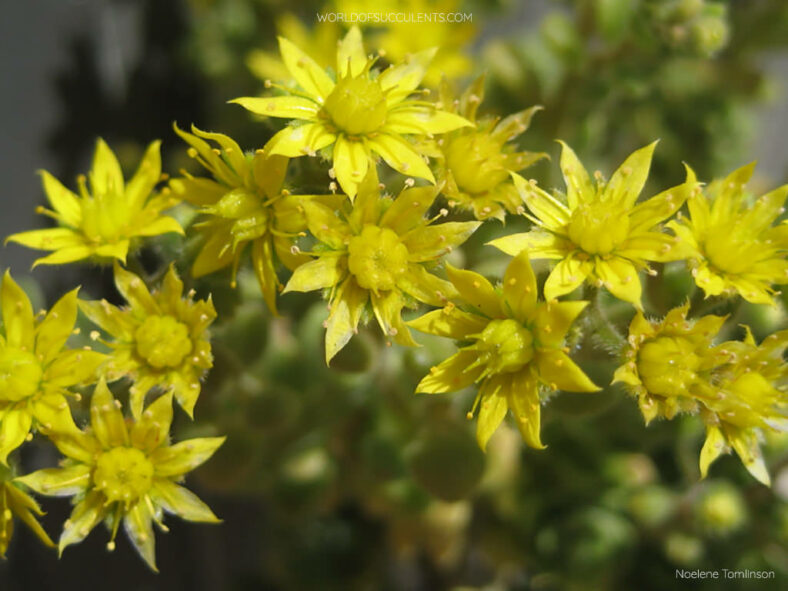Aichryson tortuosum subsp. bethencourtianum is similar to Aichryson tortuosum subsp. tortuosum, but they can be distinguished by their leaves. The leaves of Aichryson tortuosum subsp. bethencourtianum are covered with non-glandular hairs, while the latter's leaves are covered with glandular hairs.
Scientific Name
Aichryson tortuosum subsp. bethencourtianum (Bolle) Bañares
Synonym(s)
Aeonium bethencourtianum, Aichryson bethencourtianum, Aichryson tortuosum var. bethencourtianum, Macrobia bethencourtiana, Sempervivum bethencourtianum
Scientific Classification
Family: Crassulaceae
Subfamily: Sempervivoideae
Tribe: Aeonieae
Genus: Aichryson
Etymology
The subspecific epithet "bethencourtianum" (pronounced "bet-en-cort-ee-AH-num") honors Jean de Béthencourt (1362-1425), a French explorer who led an expedition to the Canary Islands in 1402, landing first on the north side of Lanzarote.
Origin
Aichryson tortuosum subsp. bethencourtianum is native to the Canary Islands. It occurs in humid rocks on the island of Fuerteventura.
Description
Aichryson tortuosum subsp. bethencourtianum, also known as Aichryson bethencourtianum, is a densely branched succulent shrublet with more or less woody branches that bears hairy, green leaves often tinged purplish-red. It can grow up to 6 inches (15 cm) tall. The leaves are obovate and can measure up to 0.7 inches (1.8 cm) in length, 0.4 inches (1 cm) in width, and 0.25 inches (0.6 cm) in thickness.
In late spring or summer, Aichryson tortuosum subsp. bethencourtianum produces star-shaped flowers with 8 to 9 golden-yellow petals and hairy sepals the same color as the leaves. The flowers appear in few-flowered clusters on leafy stalks and can reach up to 0.5 inches (1.2 cm) in diameter.

Forms of Aichryson tortuosum subsp. bethencourtianum
Hybrids of Aichryson tortuosum subsp. bethencourtianum
How to Grow and Care for Aichryson tortuosum subsp. bethencourtianum
Light: Aichryson tortuosum subsp. bethencourtianum thrives in full sun to partial shade. However, it prefers slightly shaded areas during summer, especially in the hotter afternoon hours. When growing indoors, ensure the plant receives plenty of bright, indirect light to prevent it from becoming leggy and stretched.
Soil: Unlike most succulents, this plant requires sandy loam or regular potting soil amended with perlite. Avoid placing it in premade soil mixes designed for succulents, as it needs more moisture than these mixes typically provide.
Temperature: Aichryson tortuosum subsp. bethencourtianum does not like hot or dry weather, so it may go dormant in summer. It grows best in USDA Plant Hardiness Zones 9b to 11b, with average minimum winter temperatures ranging from 25°F to 50°F (- 3.9°C to 10°C).
Watering: Water the plant thoroughly in the spring and fall, allowing the soil to dry between waterings. During the winter, water it more sparingly. Although this plant requires more water than most succulents, too much moisture can lead to root rot. Stop watering except in arid conditions during its summer dormancy.
Fertilizing: Apply a water-soluble fertilizer diluted to half-strength during the growing season to stimulate growth and improve the plant's appearance.
Repotting: If growing Aichryson tortuosum subsp. bethencourtianum in a container, repot it as needed during the spring. Choose a container with drainage holes to prevent root rot from occurring.
Propagation: This plant can be easily propagated by stem cuttings or seeds. Take cuttings during the growing season and allow the cut ends to dry for several days before planting. The best time to sow the seeds is during the spring.
Learn more at How to Grow and Care for Aichryson.
Toxicity of Aichryson tortuosum subsp. bethencourtianum
Aichryson tortuosum subsp. bethencourtianum is considered non-toxic, making it safe to grow around children and pets.
Links
- Back to genus Aichryson
- Succupedia: Browse succulents by Scientific Name, Common Name, Genus, Family, USDA Hardiness Zone, Origin, or cacti by Genus
Photo Gallery
Click on a photo to see a larger version.


